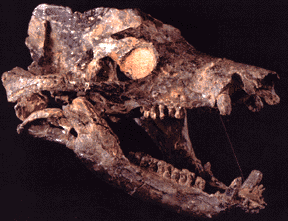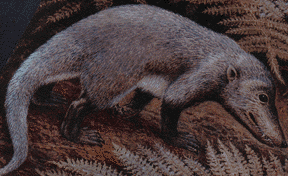
Dvinia
prima -Amalitzky, 1922- skull
Therapsida: Cynodontia:
Dviniidae
Locality: Sokolki, Malaya Severnaya Dvina
River, Arkhangelsk Region, northern European Russia
Age: Late Permian, 250 million
years ago
Meaning of name: "from the Dvina River"
Along
with anamodonts, gorgonopsids, and therocephalians,
small cynodonts became widely
distributed by the Late Permian.
The cynodonts fed on anything they could find,
but most likely on insects.
This small, omnivorous therapsid is clearly advanced
in having a temporal opening
so large that only a thin bar of bone remains to
separate it from the eye socket.
In the cynodont Dvinia, the long snout probably
possessed whiskers
and the body might have been covered by a tousled rigid fur,
that
made this animal similar externally to some mammals.
Of all the therapsids on
display in this exhibition, this is the one closest to the mammals.
The Permian
cynodonts were ancestors of Mesozoic mammals.
In contrast to mammals, the brain
in cynodonts was comparatively much less advanced.
The jaws and eyes constituted
the main part of their skull,
whereas the brain case occupied a relatively small
space.






